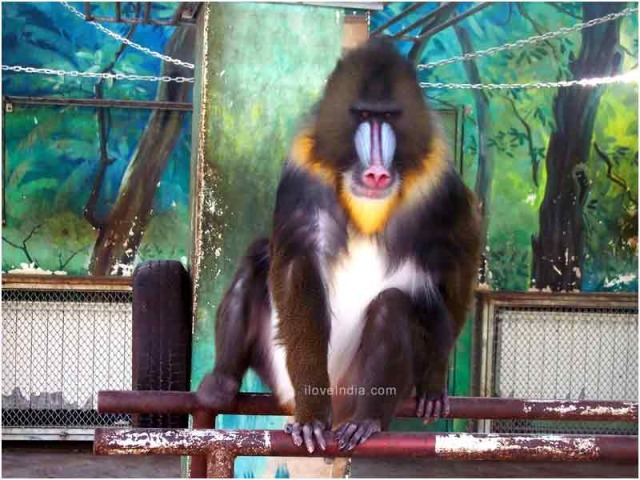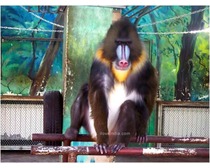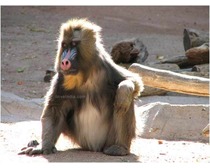Mandrill is the largest species of monkey on earth, residing in the rainforests of equatorial Africa. Explore the article to know some interesting facts and amazing information on mandrills.
Facts About Mandrill
The Mandrill is the largest species of monkey on earth. It is a primate belonging to the Cercopithecidae family and is also closely related to the baboon and the drill. In fact, both mandrill and drill were earlier classified as baboons of the Papio genus, but recent researches have separated the former into an individual genus, i.e. Mandrillus. Contrary to the baboons, the mandrills possess an ape-like structure. The physical description of mandrill entails its olive-colored fur and a colored face. A female mandrill attains sexual maturity at the age of 3.5 and the color continues to become strong as the mandrills attain sexual maturity. Mandrills are a ‘threatened’ species, often hunted as bushmeat is considered as a delicacy by many Africans. They can survive up to 20 years in the wild on an average and 30 years in captivity. Read on to know some interesting facts and amazing information on mandrills.

Fast Facts
Kingdom: Animalia
Phylum: Chordata
Class: Mammalia
Order: Primates
Family: Cercopithecidae
Genus: Mandrillus
Species: M. sphinx
Height: 22-32 inches
Weight: 11.5-30 kg
Diet: Fruits, roots, and animals such as insects, reptiles, and amphibians
Lifespan: 20 years in the wild
Range: Tropical rainforests of equatorial Africa
Gestation Period: 6-7 months
Interesting & Amazing Information On Mandrills
-
The habitat range of mandrills includes the tropical rainforests of equatorial Africa and occasionally woodlands of southern Cameroon, Gabon, Equatorial Guinea, and Congo. Recent research suggests that mandrill populations found in north and south of the Ogooué River, in West Central Africa, are so genetically different from others so as to be classified as a separate subspecies.
-
Primarily, mandrills are terrestrial monkeys, who roam around in troops headed by a dominant male and the troop includes a dozen or more females and young Mandrills.
-
Mandrills have a long, heavy doglike muzzle with bright red skin, which covers the chin, mouth, and nose and extends upward in a narrow strip, to the striking, close-set, yellow-brown eyes. The cheeks are bright blue in color and folded into an intricate pattern of ridges.
-
The adult male mandrills are believed to be solitary; however they do hang out in groups, which can comprise of as many as 200 members on an average. The accurate estimates for their group size are rather difficult to figure out.
-
The largest mandrill group that has been observed contained over 1300 monkeys in Lopé National Park, Gabon. This has been the largest ever recorded aggregation of these human primates.
-
Leopards, pythons and humans are the main natural predators of mandrills. They are hunted throughout their range with guns or dogs and nets.
-
The young mandrills are usually born between January and April. This species of monkeys mate all through the year during the estrous cycle, occurring once every 33 days. 13-14 months is the inter-birth interval period.
-
Infant mandrills are born with fur on their body and their eyes open. In the first two months, the infants have a black coat and pink skin. They are seen to be clinging to their mother’s belly and are capable of supporting their own body weight. The bonds with the daughters last longer than with the sons.
-
Mandrills spend much of their time on the ground, even as they are capable of climbing trees and do so when they want to sleep.
-
For mandrills the mating season lasts from June to October and the breeding takes place every two years. During the breeding period the male follow and guard the female.
-
The count of mandrills has been declining rapidly due to various factors such as deforestation and specially hunting which poses a great threat to the species. The existence of mandrills faces immense threat especially in the Republic of the Congo; however, various efforts are being made to save this wonderful species.
-
Mandrills are omnivores and feed on fruits and insects. They also eat bark, lianas, fibers, stems and leaves. As far as insects are concerned mandrills feed on spiders, ants, crickets, snails, beetles, termites and scorpions.


See also
More from iloveindia.com
- Home Remedies | Ayurveda | Vastu | Yoga | Feng Shui | Tattoos | Fitness | Garden | Nutrition | Parenting | Bikes | Cars | Baby Care | Indian Weddings | Festivals | Party ideas | Horoscope 2015 | Pets | Finance | Figures of Speech | Hotels in India : Delhi | Hyderabad | Chennai | Mumbai | Kolkata | Bangalore | Ahmedabad | Jaipur
- Contact Us Careers Disclaimer Privacy Policy Advertise With Us Lifestyle Sitemap Copyright iloveindia.com. All Rights Reserved.




